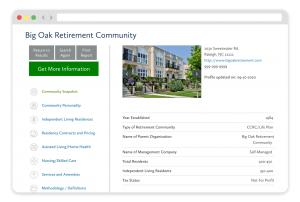As we discussed in last week’s blog post, the “Peak 65” portion of the Baby Boomers — the generation’s final cohort to reach retirement age — faces a financial landscape that is promising for some but uncertain for many. Indeed, the contrast is striking: While Baby Boomers collectively control a significant portion of American wealth — amassing an estimated $80 trillion in assets — a 2024 Financial Security Trends Survey by AARP reveals that 1 in 5 Americans age 50 and older have no retirement savings.
This disparity in retirement savings raises important questions about the future of the senior living industry and the ability of Peak 65 retirees to pay for the care they may need in their later years. Will those retiring over the next 10 to 20 years be able to afford many of the senior living options available today? And how can society as a whole rise to the moment to address this challenge?
>> Related: A Stark Contrast in “Peak 65” Baby Boomers’ Retirement Savings Pictures
Polarity of Baby Boomers’ retirement savings
To understand the gravity of this issue, it’s essential to break down the wealth distribution within the Baby Boomer generation. The Federal Reserve Board’s 2022 Survey of Consumer Finances shows that wealth among Americans aged 65 and older is highly concentrated.
For instance, the survey found that the top 1% of Americans age 65+ hold around 30% of all wealth owned by those over 65. Given that there were around 58 million people in the U.S. age 65+ as of 2022, that top 1% represents only around 580,000 people! Meanwhile, the bottom 50% of Americans who are 65 or older hold just 4% of that age group’s total wealth. It’s important to note that many within this bottom half live on fixed incomes and have little to no retirement savings.
These findings suggest that the Baby Boomers in those top percentages — the ones with substantial investments, properties, and other assets — are well-positioned for a comfortable retirement. A large portion of their peers, however, face financial uncertainty.
The 2024 AARP survey not only revealed that about 20% of people over 50 have no retirement savings at all, but perhaps even more alarming, it found that nearly half (45%) of Baby Boomers acknowledge that their retirement savings are likely insufficient to maintain their desired lifestyle during retirement.
>> Related: Luxury Senior Living Communities Meet a Growing Market of Affluent Retirees
The impact on retirement community access
The implications of this financial divide may be profound for the senior living industry. For the wealthier set of Baby Boomers, premium retirement communities with high entry fees and/or luxury amenities will remain accessible. But for many others, the rising costs of assisted living, nursing homes, and even independent living retirement communities could become a significant barrier to receiving the housing they need or the long-term care services they may eventually require.
According to the Genworth Cost of Care Survey, the 2025 national median cost of an assisted living facility is around $6,077 per month, and the cost of a nursing home can soar to over 9,555 for a semi-private room and $10,965 per month for a private room. Keep in mind this is an average; the range can be substantially higher in some areas. With the financial resources of many Baby Boomers stretched thin or non-existent, these long-term care prices could be prohibitive for a large number of retirees.
Also keep in mind that most long-term care services are not covered under Medicare. The cost of assisted living and non-medical care in a nursing home generally must be paid out-of-pocket by the care recipient (or their family), or by long-term care insurance. Only if a person exhausts their financial resources, qualifying them for Medicaid, would such care be covered (and even then, only in Medicaid-certified facilities — not private-pay facilities).
>> Related: A Little-Known Detail about Medicaid Qualification and Paying for Long-Term Care
Will Peak 65 Baby Boomers be able to afford senior living?
Given the current wealth disparities of the Baby Boomer generation, the question remains: Over the next 10 to 20 years, will most new retirees (those Peak 65ers) be able to afford the senior living options available today? For a significant portion of this generation, the answer seems uncertain at best.
For those without sufficient retirement savings, relying on Social Security will likely not provide enough to cover the costs of senior living, much less most retirement communities, especially when factoring in inflation and the increasing costs of healthcare. Consider the fact that as of January 2025, the average monthly Social Security retirement benefit was just $1,976 — less than $24,000 per year (although the maximum possible Social Security benefit in 2025 for someone at full retirement age [FRA] is around $4,000 per month).
There are some existing senior living options for very low-income seniors, such subsidized senior housing and rental assistance programs from the U.S. Department of Housing and Urban Development (HUD). For those in need of long-term care and who qualify financially, those previously mentioned Medicaid-certified nursing homes may be an option. The challenge is that all of these programs have limited capacity and often have lengthy waiting lists.
As the Peak 65 cohort retires and ages, the need for affordable senior housing will continue to grow alongside the desire for high-quality, reasonably priced care. At the same time, the already strained current system will likely become inadequate to serve this increasing demand.
>> Related: Outside-the-Box Solutions for Middle-Market Senior Living
Creating more affordable senior living and care options
The growing financial challenges faced by a large percentage of Baby Boomers highlight the need for more senior living options — including more affordable options. Policymakers and senior living industry leaders alike must recognize that not all older adults have the financial resources to afford a move to a retirement community or private-pay long-term care facility (much less a luxury community).
There is an urgent need to develop more affordable senior housing and care alternatives that can meet the growing demand we will experience in the coming years from the Baby Boomers — particularly for that estimated 45% who lack sufficient retirement savings to maintain their current lifestyle or pay for their future long-term care needs.
Societal solutions
At the societal level, one potential solution could involve expanding government programs like HUD’s Section 202 Housing for the Elderly, which incentivizes the development of affordable rental housing for seniors with very low incomes. In addition to creating senior living units, the Section 202 program also helps residents coordinate supportive services available in their broader community, enabling them to live independently with help for tasks like cleaning, cooking, and transportation.
Another viable option may be incentivizing cities and towns to develop additional senior living units using innovative models such as cooperative senior housing (also called senior living co-ops), intergenerational communities, homesharing programs, naturally occurring retirement communities (NORCs), or rent-controlled communities, all of which could help bridge the affordability gap for many Peak 65 Baby Boomers.
New senior living industry options
The senior living industry will also need to rethink pricing structures and explore cost-effective alternatives to meet the needs of the large contingency of Baby Boomers who lack substantial retirement savings. This includes new options for economically priced independent living retirement communities as well as innovative solutions for home-based long-term care.
As we recently discussed, the continuing care at home (CCAH) model is one option being offered by a growing number of continuing care retirement communities (CCRCs or life plan communities). CCAH meets the senior living preference of many older adults to remain in their existing home while also providing a more affordable alternative to meet their potential care needs.
>> Related: The Best of Both Worlds: A Smaller CCRC Unit Can Be a Big Win
A challenge society and the senior living industry must solve
The financial disparity within the Peak 65 cohort of the Baby Boomer generation will undoubtedly have a lasting impact on the senior living industry. While some retirees will enjoy a comfortable, financially secure retirement, many others will face difficult choices as they navigate the cost of senior housing and healthcare with limited financial resources.
To remain viable in the decades to come, the senior living industry must find innovative ways to adapt to these financial disparities by creating additional affordable housing options and rethinking how long-term care is delivered. This evolution is imperative not only for the continued success of the industry, but also to ensure that all older adults — regardless of their financial situation — can safely age with dignity and access the support they need.
As the Baby Boomer generation grows older, the need for more inclusive, sustainable, and affordable senior living and care solutions also becomes ever more pressing for our nation as a whole. The time to address this growing societal challenge is now — before the financial divide deepens further, leaving too many older adults without the security and care they deserve. Solutions at the national and local level must be devised to meet this moment.

FREE Detailed Profile Reports on CCRCs/Life Plan Communities
Search Communities






